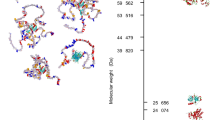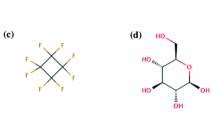Abstract.
The behaviour of water in the presence of proteins and DNA as elucidated by nuclear magnetic resonance is reviewed. The picture that emerges is that in dilute solution only those water molecules in the interior of the biopolymers or in clefts have their motions substantially affected. In concentrated systems the situation is more complicated because many more motions have to be considered, but there is no evidence of special effects due to the biopolymers being present. The case of nonfreezing water in protein solutions is considered, and it is suggested that this is not evidence for ‘bound’ water but simply due to the effects of the inhibition of protein precipitation.
Similar content being viewed by others
Author information
Authors and Affiliations
Rights and permissions
About this article
Cite this article
Belton, P. Nuclear magnetic resonance studies of the hydration of proteins and DNA . CMLS, Cell. Mol. Life Sci. 57, 993–998 (2000). https://doi.org/10.1007/PL00000752
Issue Date:
DOI: https://doi.org/10.1007/PL00000752




